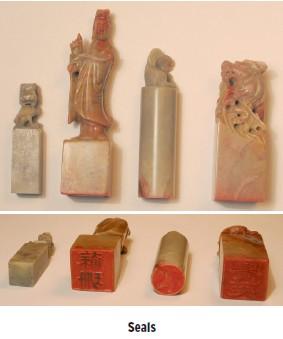Chinese Brush Painting (11 page)
Read Chinese Brush Painting Online
Authors: Caroline Self,Susan Self

Painting the Plant Characters
Try this paint-by-number game. Make each stroke in order, starting top right, working down, and then moving left. Look carefully at the character when you finish.
Look at Orchid. Can you see parts that look like two gates? These represent the gates to the Water Fairy’s garden. She is the goddess of water. Inside her garden are water, rocks, orchids with a wonderful fragrance, and butterflies flitting around. These things are all represented in the character for orchid...can you see them?
Now look at Pine and Bamboo. What do you see?


Using Seals
Usually when an artist finishes a painting, he paints his name character, and under that he stamps a design with red paste ink. The design, and the block that makes it, is called a
seal
.
Seals can be round, square, oval, or any shape. The design of the person’s name may have one or more characters, ancient pictographs, or a zodiac animal.

A fun thing to do is to make your own seal. You can use firm clay for a one-time seal, or clay that can be baked or fired for a seal you use over and over. Smooth a flat surface into the clay and use a pencil or fine point to carve your initials or a design in reverse. Paint the surface of the clay with black paint and press on paper. Try several times to get the right amount of paint to make a good print.
If you don’t make a clay seal, you can use your thumbprint to identify your painting. Your thumbprint is very personal, and no one else has one like yours; this makes it good to use for your signature.
The placement of a seal is important. It usually goes under the characters for the artist’s name. If a painting includes many characters describing it, as a landscape painting might, the characters go down the right side of the page or into another empty space to leave room for the artist’s name and seal under it. If you use only the name character and the seal, they may go on the part of the page called the “back door.” The back door is an open space that is opposite the main direction of the subject. For example, if the branches of the pine tree go mainly to the left, the back door would be low on the right.


Painting
Orchid

The orchid is one of the most important subjects in Chinese painting. It belongs to the set of classic subjects called the Four Gentlemen: orchid, bamboo, plum blossom, and chrysanthemum. Over many years, artists have developed a standard way of painting the orchid in black and white, with variations of gray.
The orchid is admired for its long, flowing leaves and graceful flower, which has a delicate fragrance. The plant therefore suggests an elegant lady performing a dance.
The orchid is a wildflower, not a garden flower. It grows near water and rocks. Its slender leaves, like blades of grass, bend as they grow longer. The blossoms are tucked in among the leaves and are smaller than most Western orchids.
Traditional Chinese painting shows two types of orchids. The Lan orchid has only one blossom on a stem. The Hsu orchid has a long stem with many blossoms along its length.
In this chapter, you will learn how to paint the Lan orchid in the boneless style. You have already learned to make orchid leaves, because they are nothing more than curved and twisted brushstrokes. Each orchid petal is also made with a single stroke. You define the shape of the petal by pressing and lifting the brush.
Deciding where to place the parts of the orchid on the paper is important. The goal is to create elegant and simple lines reaching out to the open spaces on the page. The leaves bend to the left and to the right and vary in size and direction. The strong, dark leaves protect the pale blossoms in between them.
The next page shows some examples of different orchid paintings that show variety in the leaves and petals.



This grouping of two flowers and a bud has a simple leaf arrangement, with small leaves at the bottom. The open space created where two leaves cross is called a “Buddha’s eye” because the space has the shape of an eye. This example shows a large Buddha’s eye.

This composition has a long, graceful leaf arrangement reaching outward. The three blossoms are tucked in between the leaves. Here, the crossing leaves create a small Buddha’s eye.
